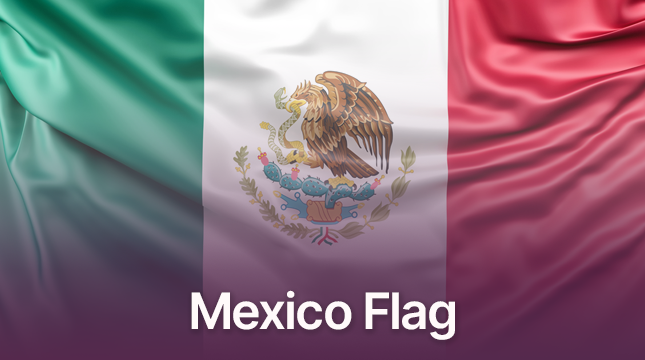The Mexican flag, a vibrant tricolor of green, white, and red with a striking emblem at its center, is more than just a national symbol—it is a representation of Mexico’s rich history, culture, and enduring values. With each color and symbol woven into the design, the flag embodies the struggles, triumphs, and hopes of the Mexican people.
Origins and Evolution of the Mexican Flag
The history of the Mexican flag dates back to the early 19th century when Mexico began its struggle for independence from Spain. While the design has undergone modifications over the centuries, the fundamental symbolism has remained. The modern Mexican flag was officially adopted on September 16, 1968, during the country’s Independence Day celebrations, though its colors and central emblem are rooted in Mexican heritage.
The Colors of the Mexican Flag and Their Meaning
Each of the three colors on the Mexican flag holds significant meaning:
- Green: Originally, this color represented independence from Spanish rule. Today, green is widely seen as a symbol of hope, as well as a nod to Mexico’s lush and fertile lands.
- White: Historically, white symbolized the purity of Catholicism, which was a central part of Mexican identity following the Spanish conquest. Today, it also represents peace and unity among the people of Mexico.
- Red: Red is a tribute to the courage of Mexican patriots who shed their blood for the nation’s freedom. It stands as a reminder of the sacrifices made during the fight for independence and serves as a symbol of strength and national pride.
The Iconic Coat of Arms
At the center of the white stripe lies Mexico’s coat of arms, featuring an eagle perched on a prickly pear cactus, holding a snake in its beak and talon. This emblem is deeply tied to Aztec mythology and has profound meaning.
The Aztec Legend Behind the Coat of Arms
According to Aztec legend, their gods instructed the people to search for a specific sign: an eagle devouring a serpent while standing on a cactus. This location would mark the spot for establishing their new city. After a long journey, they found this scene on an island in Lake Texcoco, leading to the founding of Tenochtitlan, the heart of the Aztec Empire and modern-day Mexico City. The emblem represents resilience, the connection to ancestral roots, and the ability to thrive despite challenges.
Symbolism of the Eagle, Snake, and Cactus
- The Eagle: In Mexican culture, the eagle is a symbol of strength, power, and independence. It represents the spirit of the Mexican people and their determination to protect their land and heritage.
- The Snake: The serpent in the eagle’s beak has often been interpreted as representing adversaries or challenges that the Mexican people have conquered over time.
- The Cactus: The nopal, or prickly pear cactus, grows abundantly in Mexico’s desert landscapes, symbolizing endurance and adaptability. It is also an emblem of Mexican flora and an essential part of the national identity.
Common Questions About the Mexican Flag
1. What bird is on the Mexican flag?
The bird featured on the Mexican flag is the golden eagle, Mexico’s national bird. Depicted with a snake in its beak, the golden eagle is perched on a nopal cactus, symbolizing strength, resilience, and the founding legend of Tenochtitlan.
2. What do the colors of the Mexican flag mean?
- Green symbolizes hope and the country’s rich land.
- White represents purity, unity, and peace.
- Red commemorates the sacrifices made by the Mexican patriots during the struggle for independence.
3. When was the Mexican flag adopted?
The current design of the Mexican flag was officially adopted on September 16, 1968. However, earlier versions with similar elements date back to the early 19th century, shortly after Mexico’s independence from Spain.
4. Why is the nopal cactus significant in the Mexican flag?
The nopal cactus signifies resilience, as it can thrive in harsh conditions. It is a symbol of Mexican identity and a tribute to the founding legend of Tenochtitlan, representing the strength and perseverance of the Mexican people.
5. Are there other versions of the Mexican flag?
Yes, Mexico has various official flags with slight differences for specific purposes. For example:
- The naval ensign includes the same tricolor design but may feature additional symbols.
- The presidential standard also has unique elements for ceremonial use.
These variations honor different aspects of Mexico’s heritage while maintaining the core elements of the national flag.
Celebrating Mexican Flag Day
In Mexico, Flag Day (Día de la Bandera) is celebrated each year on February 24. Established in 1937, this national observance is dedicated to honoring the flag’s significance in Mexican history and culture. Across the country, ceremonies and events are held to celebrate the flag and the values it represents.
Conclusion
The Mexican flag is a testament to the country’s complex history, vibrant culture, and the spirit of its people. Each element—from the colors to the iconic coat of arms—tells a story of independence, resilience, and pride. Recognized worldwide, the Mexican flag is a powerful symbol of national identity, uniting Mexicans both at home and abroad.

